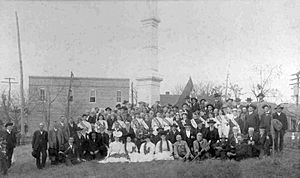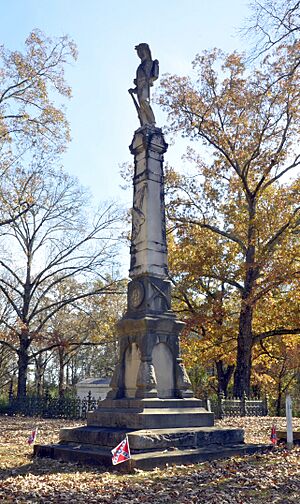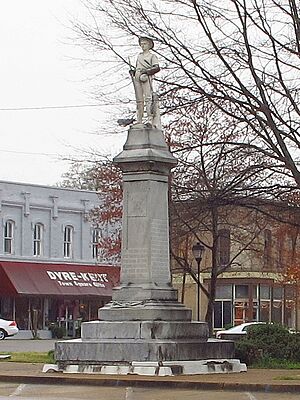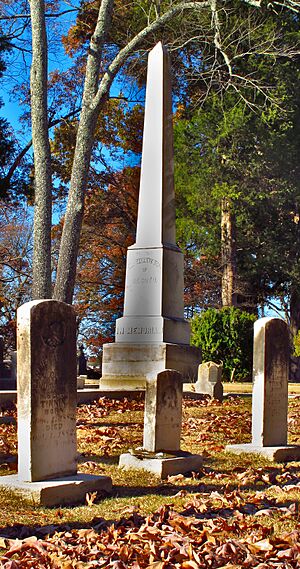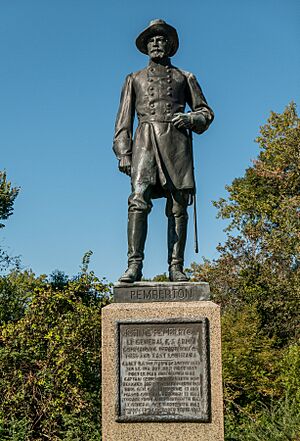List of Confederate monuments and memorials in Mississippi facts for kids
This article is about Confederate monuments and memorials in Mississippi. These are public displays and symbols that remember the Confederate States of America (CSA), its leaders, or soldiers from the American Civil War. They are part of how the Civil War is remembered in the South.
These symbols include statues, flags, special holidays, and the names of schools, roads, parks, and other public places. This list does not include people connected to the start of the Civil War or white supremacy if they were not also linked to the Confederacy.
Contents
Places with Confederate Monuments
Mississippi has at least 131 public places with Confederate monuments.
At the State Capitol
- Confederate Monument: This monument is in Jackson, Mississippi, near the Old Capitol Museum. It was put up in June 1891. Interestingly, a former slave and Republican politician, John F. Harris, spoke in favor of it.
- Women of the Confederacy Monument: This monument was added in 1917 on the south side of the Capitol grounds. It cost $20,000 and was made by Belle Kinney Scholz. The monument shows two women and a wounded soldier. One woman gives the soldier a palm branch, a sign of victory even in death. Above them, a figure named 'Fame' places a wreath on the woman's head. The monument honors mothers, daughters, sisters, and wives. It also has a quote from Jefferson Davis praising these women.
State Symbols
- State Flag: The Mississippi state flag used from 1984 to 2020 included the Confederate Battle Flag.
- Mississippi National Guard Seal: The seal of the Mississippi National Guard shows the old state flag (with the Confederate Battle Flag) flying over a soldier.
State Holidays
Mississippi celebrates two holidays related to the Confederacy:
- Robert E. Lee Birthday: This day honors Confederate General Robert E. Lee. It is celebrated on the third Monday of January, along with Martin Luther King, Jr. Day.
- Confederate Memorial Day: This day remembers Confederate soldiers. It is celebrated on the last Monday of April.
Buildings
Several buildings in Mississippi are named after Confederate figures:
- Greenwood: The Confederate Memorial Building is located here.
- Hattiesburg: Jefferson Davis Hall is at Pearl River Community College.
- Jackson: The Robert E. Lee Building is in Jackson.
- Oxford: Lamar Hall (built 1977) is at the University of Mississippi.
Monuments
Courthouse Monuments
Many counties in Mississippi have Confederate monuments on their courthouse grounds:
- Brandon: The Rankin County Confederate Monument was put up in 1907.
- Carrollton: A Confederate Monument and flag are at the Carroll County Courthouse (1905).
- Charleston: This town has a Confederate Monument.
- Cleveland: A Confederate Monument was built in 1908 by a group called the United Daughters of the Confederacy (UDC).
- Columbus: The Lowndes County Confederate Monument was dedicated in 1912.
- Corinth: A statue of Col. William P. Rogers (1895) was moved to the Alcorn County courthouse in 1920.
- De Kalb: A Confederate Monument stands on the courthouse grounds.
- Ellisville: The Jones County Courthouse has a Confederate Monument.
- Greenville: A Confederate Monument was put up in 1909 by the UDC. It has quotes from Jefferson Davis and Robert E. Lee.
- Greenwood: A Confederate Monument was dedicated in 1913.
- Gulfport: The Confederate Monument was built in 1911.
- Hattiesburg: A Confederate Memorial was placed here in 1910 by the UDC.
- Hazlehurst: A Confederate Monument was put up in 1917.
- Kosciusko: The Attala County Courthouse has a Confederate Monument (1911).
- Laurel: A Confederate Memorial was dedicated in 1912.
- Lexington: A Confederate Monument was put up in 1908.
- Macon: The Confederate Memorial Monument was built in 1901.
- Meridian: A Confederate Monument was dedicated in 1912.
- Oxford: Oxford has two Confederate monuments. One is the Confederate Monument (1907) showing a Confederate soldier.
- Philadelphia: A Confederate Monument was put up in 1912.
- Port Gibson: A Confederate Monument was dedicated in 1900.
- Quitman: The Clarke County Courthouse has a Confederate Monument (1911).
- Raymond: A Confederate Monument was put up in 1908.
- Ripley: A Confederate Monument was built in 1911 but destroyed in 1970.
- Sumner: A Confederate Monument was put up in 1913.
- Tupelo: A Confederate Monument (1906) was moved to the Lee County Courthouse in the 1930s.
Other Public Monuments
- Aberdeen: A Confederate Monument is in the Old Aberdeen Cemetery (1900).
- Amory: Amory's Tribute to the Heroes of 1861–1865 was built in 1924.
- Beulah: A Confederate Monument is in Beulah Cemetery (1905).
- Biloxi:
- The Tomb of the Unknown Confederate Soldier is here.
- Beauvoir, the home of Jefferson Davis after the war, has many monuments. One is President Jefferson Davis and Sons (2008), a bronze statue by Gary Casteel. It shows Davis with his son Joe and Jim Limber, a mixed-race boy who lived with the Davis family.
- Brookhaven: A Confederate Monument is in Rose Hill Cemetery.
- Brooksville: The Our Heroes Monument was built in 1911.
- Canton: The Howcott Monument to Loyal Servants of the Harvey Scouts was put up in 1894.
- Clinton: A Confederate Monument is in Clinton Cemetery (1928).
- Columbus:
- A Confederate Monument is in Friendship Cemetery (1894).
- Another Monument to Confederate Dead is also in Friendship Cemetery (1873).
- Corinth: The Corinth Confederate Memorial was built in 1992.
- Crystal Springs: A Confederate Monument is in Crystal Springs Cemetery.
- Duck Hill: The Confederate Soldiers Monument was put up in 1908.
- Fayette: A Confederate Soldier Sculpture was built in 1904.
- Forest: A Confederate Monument is in Western Cemetery.
- Greenville: A Confederate Monument is in Greenville Cemetery.
- Greenwood: The Confederate Memorial Building was built in 1915.
- Grenada: A Confederate Monument is in the Public Square (1910).
- Hattiesburg: The Forrest County Confederate Memorial was built in 1910.
- Heidelberg: A Confederate Statue was put up in 1911.
- Hernando: The DeSoto County Confederate Monument is in Hernando Memorial Cemetery.
- Liberty: The Confederate Monument (1871) was the first Confederate monument in Mississippi.
- Louisville: A Confederate Monument was put up in 1921.
- Natchez: A Confederate Monument was built in 1890.
- Okolona: The Our Confederate Dead monument was put up in 1905.
- Oxford:
- The "To Our Confederate Dead 1861-1865" monument is in University Circle at the University of Mississippi. It was built in 1906. In 2019, university groups asked for it to be moved.
- Lamar Hall at the University of Mississippi is named for Lucius Quintus Cincinnatus Lamar II. He helped write Mississippi’s secession papers and was a Confederate ambassador.
- Longstreet Hall is named for Augustus Baldwin Longstreet, who was president of the University during the Civil War. He supported secession and slavery.
- George Hall is named for James Z. George, a Confederate politician and colonel.
- In Ventress Hall, a Tiffany stained glass window shows the University Greys. This was a group of University of Mississippi students and teachers who fought in the Civil War.
- Pontotoc: A Confederate Monument is in the town square (1919 or 1930s).
- Port Gibson: The Claiborne County's Tribute to Her Sons Who Served in the War of 1861–65 was built in 1906.
- University: A Confederate Monument is located here.
- Vaiden: The Vaiden Confederate Monument was put up in 1912.
- Vicksburg:
- Cedar Hill Cemetery: The Soldiers' Rest Confederate Monument (1893) is where about 5,000 Confederate soldiers are buried.
- Vicksburg National Military Park: This park has many monuments. The Kentucky memorial has bronze statues of Abraham Lincoln and Jefferson Davis, both from Kentucky.
- Vicksburg National Military Park: A statue of Lt. Gen. Stephen D. Lee was put up in 1909.
- Vicksburg National Military Park: A statue of Lt. Gen. John C. Pemberton was made by Edmond Thomas Quinn.
- Vicksburg National Military Park: The Texas Monument (1961) lists all Texas units that fought in the Vicksburg area.
- Vicksburg National Military Park: The Missouri Monument is for soldiers from both sides. It is where two Missouri regiments fought each other. It was dedicated in 1917.
- West Point:
- A Confederate Monument was put up in 1907.
- The Battle of Ellis Bridge Monument was built in 1994.
- Winona: A Confederate Memorial Statue was put up in 1909.
- Yazoo City: A Confederate Monument is located here.
Named Places
Some places in Mississippi are named after Confederate figures:
- Benton County (1870): Named for CSA Brig. Gen. Samuel Benton.
- Forrest County (1908): Named for a Confederate general.
- Gloster: Named for CSA Captain Arthur Willis Gloster.
- Jefferson Davis County (1906): Named for the president of the Confederacy.
- Lee County (1866): Named for Robert E. Lee.
- The City of Stonewall: Named for Confederate General Stonewall Jackson.
Water Features and Dams
- Hattiesburg:
- Jefferson Davis Lake
- Jefferson Davis Lake Dam
Roads
Many roads in Mississippi are named after Confederate figures or events:
- Bay St. Louis: Jeff Davis Drive
- Beaumont: Jeff Davis Parkway, Robert E. Lee Street
- Biloxi: Jefferson Davis Avenue
- Bogue Chitto: Beauregard Street, Lee Drive
- Corinth: Confederate Street
- De Kalb: Jeff Davis Road
- Duck Hill: Jeff Davis Road
- Florence: Robert E. Lee Drive
- Greenwood: Robert E. Lee Drive
- Hattiesburg: Bedford Forrest Road, Robert E. Lee Road
- Hollandale: Jeff Davis Road
- Holly Springs: Van Dorn Avenue
- Indianola: Jefferson Davis Drive, Stonewall Drive
- Leakesville: Jeff Davis Road
- Lexington: Robert E. Lee Street
- Long Beach: Jeff Davis Avenue
- Lucedale: Robert E. Lee Road
- Marion: Confederate Drive
- Meridian: Jeff Davis School Road
- Moss Point: Many roads are named after Confederate generals, such as Anderson Road, Beauregard Road, Forrest Road, and Robert E. Lee Road.
- New Albany: Robert E. Lee Drive
- Oxford: Jefferson Davis Drive, Lamar Avenue (named for Lucius Q. C. Lamar).
- Pascagoula: Roads like Jeb Stuart Road and Mosby Road are here.
- Picayune: Jefferson Davis Parkway, Longstreet Lane, Pemberton Place
- Prairie: Jeff Davis Road
- Senatobia: Beauregard Street, Forrest Avenue, Longstreet Lane
- Tupelo: Beauregard Street, Confederate Avenue, Jeb Stuart Street, Robert E. Lee Drive
- Vicksburg National Military Park: Pemberton Circle and Pemberton Avenue are named for John C. Pemberton.
- Waveland: Jeff Davis Avenue
- Wesson: Beauregard Road
Schools
Some schools in Mississippi were named after Confederate figures. Some have been renamed:
- Biloxi: Jeff Davis Elementary School is now Back Bay Elementary School.
- Brooklyn:
- Forrest County Agricultural High School (1916)
- South Forrest Attendance Center (1960)
- Caledonia: Caledonia High School's sports teams are called the "Confederates."
- Greenwood: Davis Elementary School is here.
- Hattiesburg:
- North Forrest Elementary School
- Jefferson Davis Hall at Pearl River Community College
- Jackson: The School Board renamed some elementary schools before the 2018–2019 school year:
- Lee Elementary School (1922) is now Shirley Elementary School.
- Jefferson Davis Elementary School is now Barack Obama Elementary School.
- George Elementary School, named for James Zachariah George, is being renamed. He signed the Mississippi Secession Ordinance.
- Oxford:
- Jeff Davis Elementary School (1959)
- University of Mississippi ("Ole Miss"):
- The Confederate Cemetery Memorial (1906) is on campus.
- The school's sports teams are called the "Rebels."
- From 1979 to 2003, the mascot was Colonel Reb.
- The name "Ole Miss" itself was how slaves sometimes addressed the mistress of a plantation.
- Lamar Hall (1977) remembers Lucius Q. C. Lamar, who owned slaves and helped draft Mississippi's secession order.
- Rolling Fork: Sharkey Issaquena Academy (a private school) has sports teams called the "Confederates."
- Starkville: A statue of Stephen D. Lee is here. He was the youngest Confederate general and the first president of the college that became Mississippi State University. The statue was put up in 1909.
Images for kids


